Analysis of Leading and Managing Change at Barnacle Bay Hotel
VerifiedAdded on 2021/02/21
|11
|3940
|86
Report
AI Summary
This report analyzes the case of Barnacle Bay Country House Hotel, focusing on the challenges of implementing wholesale cultural change within the hospitality sector. Faced with competition from a new luxury hotel, Barnacles proposed a refurbishment and cultural shift. The report explores the difficulties in enforcing this change, including lack of planning, communication barriers, and employee resistance. It then outlines a planned approach using Lewin's Change Management Model, emphasizing the importance of a structured framework for successful implementation. The report also discusses the leadership strategies and styles necessary to foster and manage this change effectively. The analysis covers aspects such as the need for effective communication, stakeholder engagement, and addressing employee concerns to ensure a smooth transition and achieve the desired outcomes of enhanced customer satisfaction and market competitiveness. The report concludes by summarizing the key elements for successful change management within the hotel industry, providing valuable insights into the practical application of change management theories and principles.
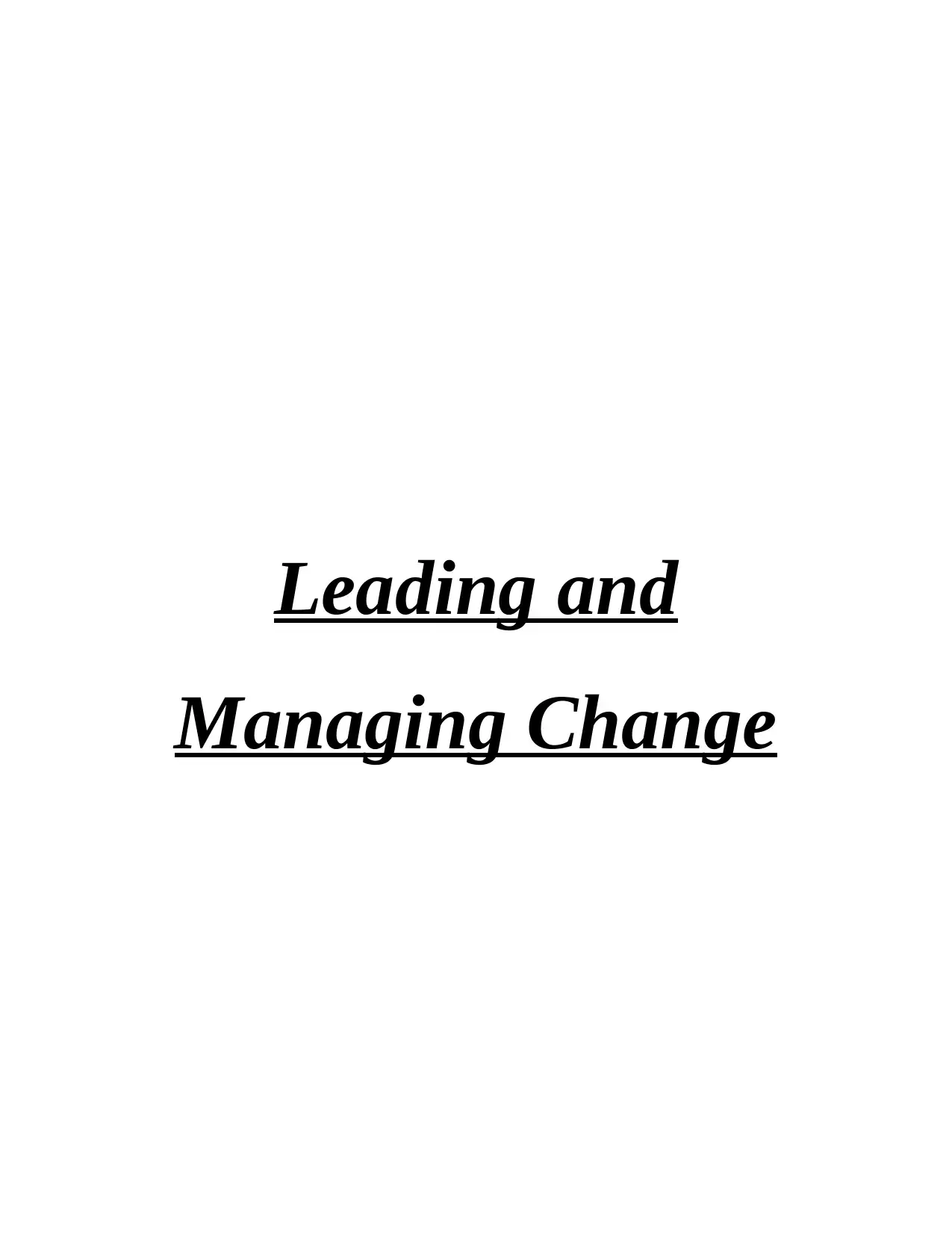
Leading and
Managing Change
Managing Change
Paraphrase This Document
Need a fresh take? Get an instant paraphrase of this document with our AI Paraphraser
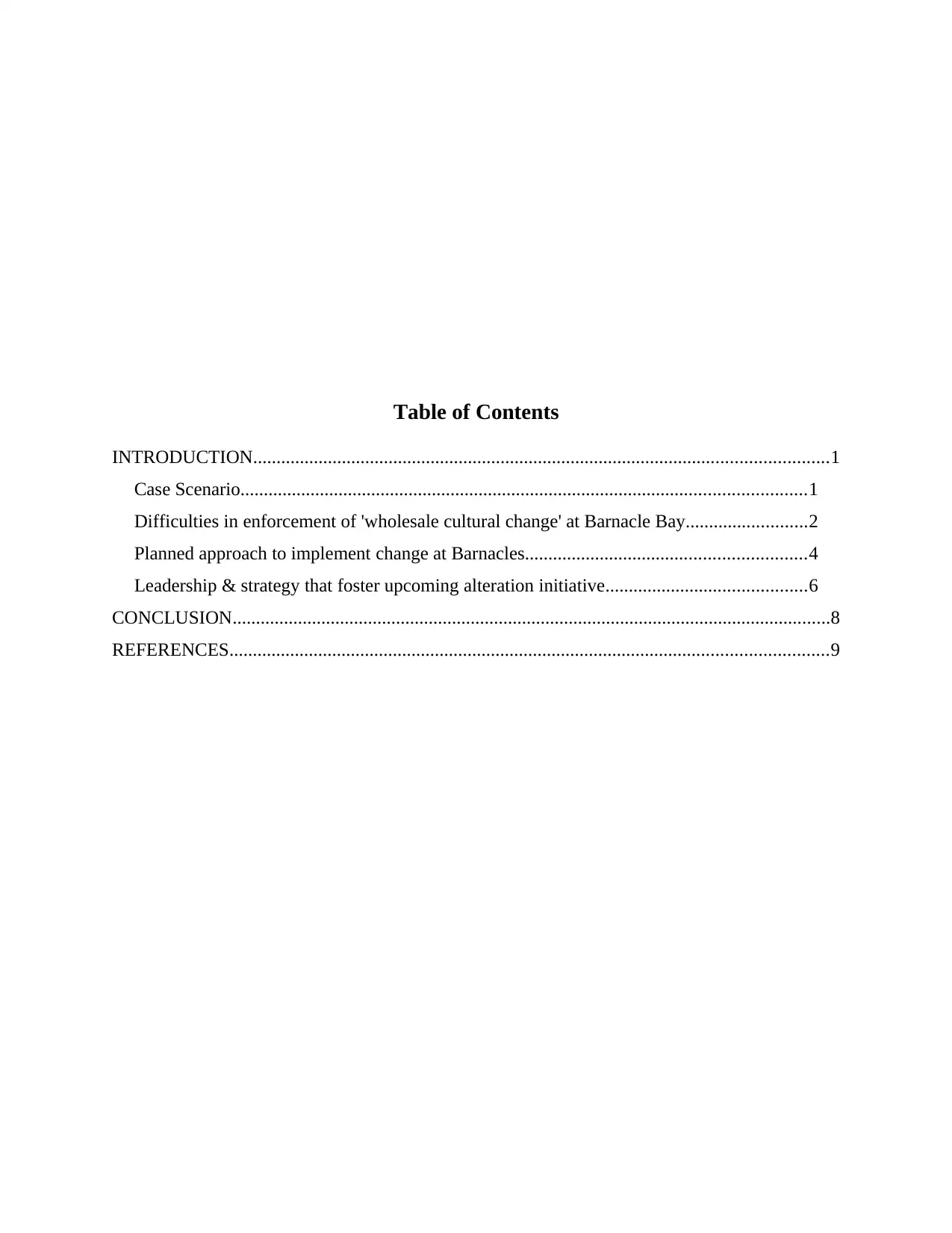
Table of Contents
INTRODUCTION...........................................................................................................................1
Case Scenario.........................................................................................................................1
Difficulties in enforcement of 'wholesale cultural change' at Barnacle Bay..........................2
Planned approach to implement change at Barnacles............................................................4
Leadership & strategy that foster upcoming alteration initiative...........................................6
CONCLUSION................................................................................................................................8
REFERENCES................................................................................................................................9
INTRODUCTION...........................................................................................................................1
Case Scenario.........................................................................................................................1
Difficulties in enforcement of 'wholesale cultural change' at Barnacle Bay..........................2
Planned approach to implement change at Barnacles............................................................4
Leadership & strategy that foster upcoming alteration initiative...........................................6
CONCLUSION................................................................................................................................8
REFERENCES................................................................................................................................9
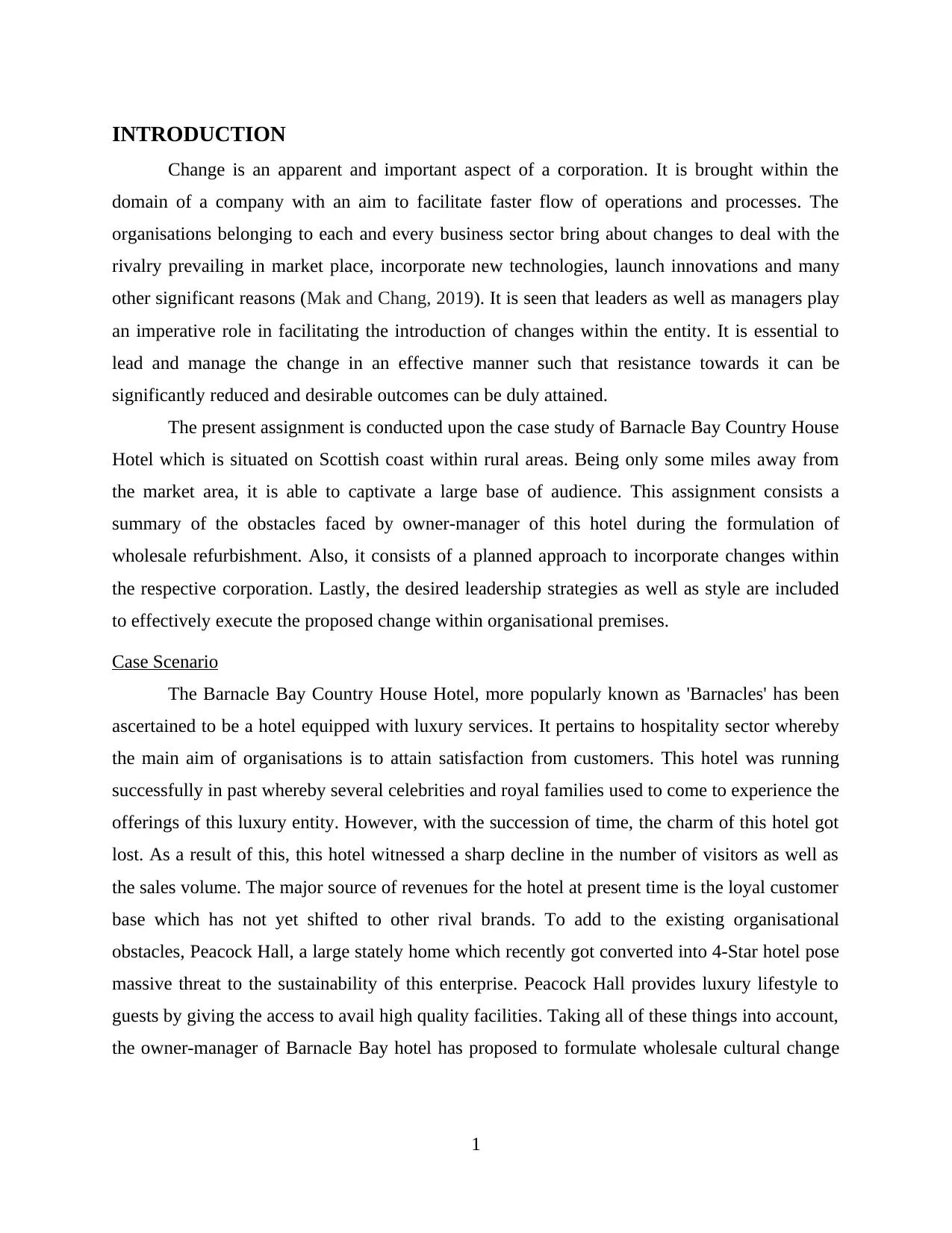
INTRODUCTION
Change is an apparent and important aspect of a corporation. It is brought within the
domain of a company with an aim to facilitate faster flow of operations and processes. The
organisations belonging to each and every business sector bring about changes to deal with the
rivalry prevailing in market place, incorporate new technologies, launch innovations and many
other significant reasons (Mak and Chang, 2019). It is seen that leaders as well as managers play
an imperative role in facilitating the introduction of changes within the entity. It is essential to
lead and manage the change in an effective manner such that resistance towards it can be
significantly reduced and desirable outcomes can be duly attained.
The present assignment is conducted upon the case study of Barnacle Bay Country House
Hotel which is situated on Scottish coast within rural areas. Being only some miles away from
the market area, it is able to captivate a large base of audience. This assignment consists a
summary of the obstacles faced by owner-manager of this hotel during the formulation of
wholesale refurbishment. Also, it consists of a planned approach to incorporate changes within
the respective corporation. Lastly, the desired leadership strategies as well as style are included
to effectively execute the proposed change within organisational premises.
Case Scenario
The Barnacle Bay Country House Hotel, more popularly known as 'Barnacles' has been
ascertained to be a hotel equipped with luxury services. It pertains to hospitality sector whereby
the main aim of organisations is to attain satisfaction from customers. This hotel was running
successfully in past whereby several celebrities and royal families used to come to experience the
offerings of this luxury entity. However, with the succession of time, the charm of this hotel got
lost. As a result of this, this hotel witnessed a sharp decline in the number of visitors as well as
the sales volume. The major source of revenues for the hotel at present time is the loyal customer
base which has not yet shifted to other rival brands. To add to the existing organisational
obstacles, Peacock Hall, a large stately home which recently got converted into 4-Star hotel pose
massive threat to the sustainability of this enterprise. Peacock Hall provides luxury lifestyle to
guests by giving the access to avail high quality facilities. Taking all of these things into account,
the owner-manager of Barnacle Bay hotel has proposed to formulate wholesale cultural change
1
Change is an apparent and important aspect of a corporation. It is brought within the
domain of a company with an aim to facilitate faster flow of operations and processes. The
organisations belonging to each and every business sector bring about changes to deal with the
rivalry prevailing in market place, incorporate new technologies, launch innovations and many
other significant reasons (Mak and Chang, 2019). It is seen that leaders as well as managers play
an imperative role in facilitating the introduction of changes within the entity. It is essential to
lead and manage the change in an effective manner such that resistance towards it can be
significantly reduced and desirable outcomes can be duly attained.
The present assignment is conducted upon the case study of Barnacle Bay Country House
Hotel which is situated on Scottish coast within rural areas. Being only some miles away from
the market area, it is able to captivate a large base of audience. This assignment consists a
summary of the obstacles faced by owner-manager of this hotel during the formulation of
wholesale refurbishment. Also, it consists of a planned approach to incorporate changes within
the respective corporation. Lastly, the desired leadership strategies as well as style are included
to effectively execute the proposed change within organisational premises.
Case Scenario
The Barnacle Bay Country House Hotel, more popularly known as 'Barnacles' has been
ascertained to be a hotel equipped with luxury services. It pertains to hospitality sector whereby
the main aim of organisations is to attain satisfaction from customers. This hotel was running
successfully in past whereby several celebrities and royal families used to come to experience the
offerings of this luxury entity. However, with the succession of time, the charm of this hotel got
lost. As a result of this, this hotel witnessed a sharp decline in the number of visitors as well as
the sales volume. The major source of revenues for the hotel at present time is the loyal customer
base which has not yet shifted to other rival brands. To add to the existing organisational
obstacles, Peacock Hall, a large stately home which recently got converted into 4-Star hotel pose
massive threat to the sustainability of this enterprise. Peacock Hall provides luxury lifestyle to
guests by giving the access to avail high quality facilities. Taking all of these things into account,
the owner-manager of Barnacle Bay hotel has proposed to formulate wholesale cultural change
1
⊘ This is a preview!⊘
Do you want full access?
Subscribe today to unlock all pages.

Trusted by 1+ million students worldwide

in the premise of corporation. This would help in effectively dealing with the queries faced by
guests and providing them high standard facilities so as to retain them for a long period of time.
Difficulties in enforcement of 'wholesale cultural change' at Barnacle Bay
In the present time, it is comprehended by leaders and managers as well that there is a
need for entity to analyse and evaluate the emerging trends in market place as this helps in
ascertainment of opportunities which can render them a competitive edge over rivals firms. In
this regard, owing to the challenge posed by the emergence of Peacock Hall, the owner-manager
of Barnacles has proposed to bring about certain imperative alterations in the premises of hotel.
For this purpose, Barnacles' management has procured funding from bank. Such funds would be
utilised by the respective hotel for the execution of wholesale refurbishment within
organisational premises. This can be explained as a process whereby restoring of old
commodities is executed in a manner such that they seem newly prepared or acquired (Smith,
2019). With the formulation of this concept within the hotel premise, Barnacle Bay Country
House Hotel would now be having new décor, furnishing, carpet, newly indoor swimming pool
and gymnasium.
To deal with the challenge of rivalry posed by Peacock Hall, Barnacle Bay has proposed
to introduce some changes within its culture. This has been referred to as wholesale cultural
change. In context of the case study, wholesale cultural change is defined as the procedure of
executing overall restructuring of present culture of the corporation (Sampaio, Hernández-
Mogollón and Rodrigues, 2019). This includes introduction of alterations in a number of
working areas as well as organisational culture. It is inclusive of deployment of existing workers
and procedures that cause unnecessary delay in provision of quality services to guests within the
premises of hotel. With reference to the case study of Barnacle Bay, it reflects the transition that
the hotel will undergo in order to build the capability to out-power the rivals persisting in the
confines of hotel sector. It means that the entity would get ready for a transformation (radical
change in the overall working and culture of the hotel) which would allow the accumulation of
effective procedures and business practices to attain a strategic edge within market. The biggest
emerging competitor of Barnacles at the present time is Peacock Hall which consists of high
quality and luxury facilities for clients. Thus, it becomes significant for the respective hotel to
carry out a review of its present processes so as to make sure that the facilities given within the
premises of Barnacles are compatible with the industry standards as well as the needs and
2
guests and providing them high standard facilities so as to retain them for a long period of time.
Difficulties in enforcement of 'wholesale cultural change' at Barnacle Bay
In the present time, it is comprehended by leaders and managers as well that there is a
need for entity to analyse and evaluate the emerging trends in market place as this helps in
ascertainment of opportunities which can render them a competitive edge over rivals firms. In
this regard, owing to the challenge posed by the emergence of Peacock Hall, the owner-manager
of Barnacles has proposed to bring about certain imperative alterations in the premises of hotel.
For this purpose, Barnacles' management has procured funding from bank. Such funds would be
utilised by the respective hotel for the execution of wholesale refurbishment within
organisational premises. This can be explained as a process whereby restoring of old
commodities is executed in a manner such that they seem newly prepared or acquired (Smith,
2019). With the formulation of this concept within the hotel premise, Barnacle Bay Country
House Hotel would now be having new décor, furnishing, carpet, newly indoor swimming pool
and gymnasium.
To deal with the challenge of rivalry posed by Peacock Hall, Barnacle Bay has proposed
to introduce some changes within its culture. This has been referred to as wholesale cultural
change. In context of the case study, wholesale cultural change is defined as the procedure of
executing overall restructuring of present culture of the corporation (Sampaio, Hernández-
Mogollón and Rodrigues, 2019). This includes introduction of alterations in a number of
working areas as well as organisational culture. It is inclusive of deployment of existing workers
and procedures that cause unnecessary delay in provision of quality services to guests within the
premises of hotel. With reference to the case study of Barnacle Bay, it reflects the transition that
the hotel will undergo in order to build the capability to out-power the rivals persisting in the
confines of hotel sector. It means that the entity would get ready for a transformation (radical
change in the overall working and culture of the hotel) which would allow the accumulation of
effective procedures and business practices to attain a strategic edge within market. The biggest
emerging competitor of Barnacles at the present time is Peacock Hall which consists of high
quality and luxury facilities for clients. Thus, it becomes significant for the respective hotel to
carry out a review of its present processes so as to make sure that the facilities given within the
premises of Barnacles are compatible with the industry standards as well as the needs and
2
Paraphrase This Document
Need a fresh take? Get an instant paraphrase of this document with our AI Paraphraser
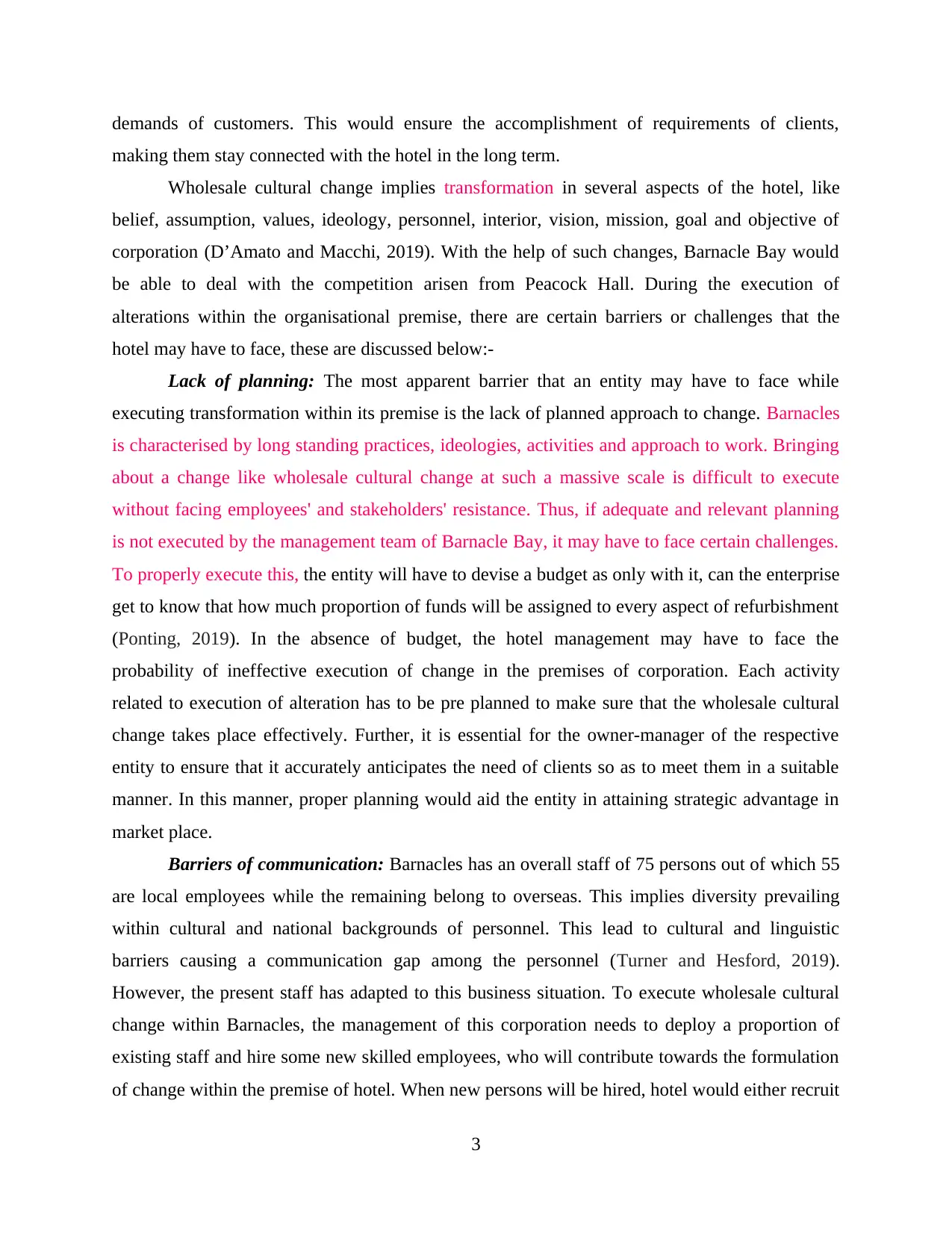
demands of customers. This would ensure the accomplishment of requirements of clients,
making them stay connected with the hotel in the long term.
Wholesale cultural change implies transformation in several aspects of the hotel, like
belief, assumption, values, ideology, personnel, interior, vision, mission, goal and objective of
corporation (D’Amato and Macchi, 2019). With the help of such changes, Barnacle Bay would
be able to deal with the competition arisen from Peacock Hall. During the execution of
alterations within the organisational premise, there are certain barriers or challenges that the
hotel may have to face, these are discussed below:-
Lack of planning: The most apparent barrier that an entity may have to face while
executing transformation within its premise is the lack of planned approach to change. Barnacles
is characterised by long standing practices, ideologies, activities and approach to work. Bringing
about a change like wholesale cultural change at such a massive scale is difficult to execute
without facing employees' and stakeholders' resistance. Thus, if adequate and relevant planning
is not executed by the management team of Barnacle Bay, it may have to face certain challenges.
To properly execute this, the entity will have to devise a budget as only with it, can the enterprise
get to know that how much proportion of funds will be assigned to every aspect of refurbishment
(Ponting, 2019). In the absence of budget, the hotel management may have to face the
probability of ineffective execution of change in the premises of corporation. Each activity
related to execution of alteration has to be pre planned to make sure that the wholesale cultural
change takes place effectively. Further, it is essential for the owner-manager of the respective
entity to ensure that it accurately anticipates the need of clients so as to meet them in a suitable
manner. In this manner, proper planning would aid the entity in attaining strategic advantage in
market place.
Barriers of communication: Barnacles has an overall staff of 75 persons out of which 55
are local employees while the remaining belong to overseas. This implies diversity prevailing
within cultural and national backgrounds of personnel. This lead to cultural and linguistic
barriers causing a communication gap among the personnel (Turner and Hesford, 2019).
However, the present staff has adapted to this business situation. To execute wholesale cultural
change within Barnacles, the management of this corporation needs to deploy a proportion of
existing staff and hire some new skilled employees, who will contribute towards the formulation
of change within the premise of hotel. When new persons will be hired, hotel would either recruit
3
making them stay connected with the hotel in the long term.
Wholesale cultural change implies transformation in several aspects of the hotel, like
belief, assumption, values, ideology, personnel, interior, vision, mission, goal and objective of
corporation (D’Amato and Macchi, 2019). With the help of such changes, Barnacle Bay would
be able to deal with the competition arisen from Peacock Hall. During the execution of
alterations within the organisational premise, there are certain barriers or challenges that the
hotel may have to face, these are discussed below:-
Lack of planning: The most apparent barrier that an entity may have to face while
executing transformation within its premise is the lack of planned approach to change. Barnacles
is characterised by long standing practices, ideologies, activities and approach to work. Bringing
about a change like wholesale cultural change at such a massive scale is difficult to execute
without facing employees' and stakeholders' resistance. Thus, if adequate and relevant planning
is not executed by the management team of Barnacle Bay, it may have to face certain challenges.
To properly execute this, the entity will have to devise a budget as only with it, can the enterprise
get to know that how much proportion of funds will be assigned to every aspect of refurbishment
(Ponting, 2019). In the absence of budget, the hotel management may have to face the
probability of ineffective execution of change in the premises of corporation. Each activity
related to execution of alteration has to be pre planned to make sure that the wholesale cultural
change takes place effectively. Further, it is essential for the owner-manager of the respective
entity to ensure that it accurately anticipates the need of clients so as to meet them in a suitable
manner. In this manner, proper planning would aid the entity in attaining strategic advantage in
market place.
Barriers of communication: Barnacles has an overall staff of 75 persons out of which 55
are local employees while the remaining belong to overseas. This implies diversity prevailing
within cultural and national backgrounds of personnel. This lead to cultural and linguistic
barriers causing a communication gap among the personnel (Turner and Hesford, 2019).
However, the present staff has adapted to this business situation. To execute wholesale cultural
change within Barnacles, the management of this corporation needs to deploy a proportion of
existing staff and hire some new skilled employees, who will contribute towards the formulation
of change within the premise of hotel. When new persons will be hired, hotel would either recruit
3
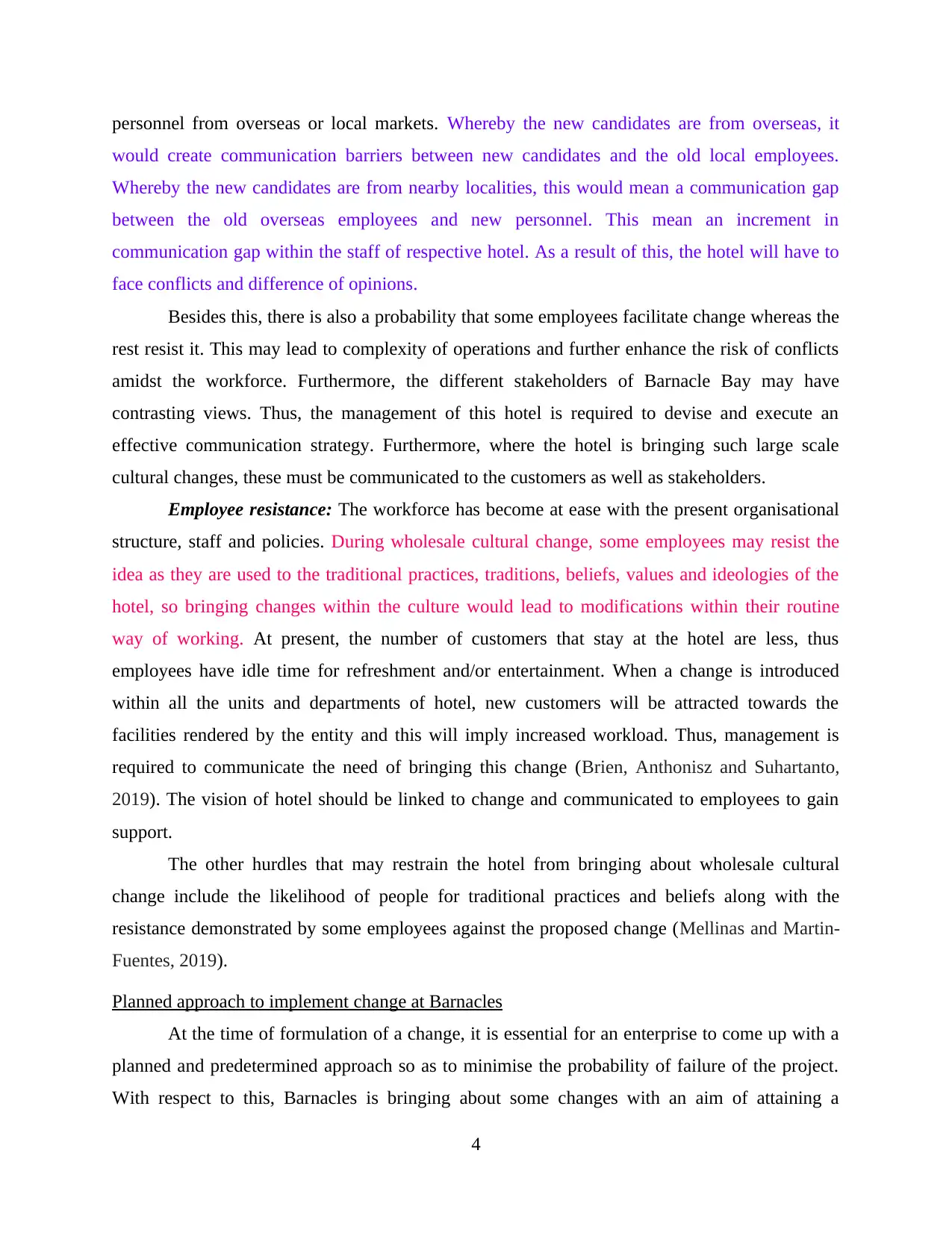
personnel from overseas or local markets. Whereby the new candidates are from overseas, it
would create communication barriers between new candidates and the old local employees.
Whereby the new candidates are from nearby localities, this would mean a communication gap
between the old overseas employees and new personnel. This mean an increment in
communication gap within the staff of respective hotel. As a result of this, the hotel will have to
face conflicts and difference of opinions.
Besides this, there is also a probability that some employees facilitate change whereas the
rest resist it. This may lead to complexity of operations and further enhance the risk of conflicts
amidst the workforce. Furthermore, the different stakeholders of Barnacle Bay may have
contrasting views. Thus, the management of this hotel is required to devise and execute an
effective communication strategy. Furthermore, where the hotel is bringing such large scale
cultural changes, these must be communicated to the customers as well as stakeholders.
Employee resistance: The workforce has become at ease with the present organisational
structure, staff and policies. During wholesale cultural change, some employees may resist the
idea as they are used to the traditional practices, traditions, beliefs, values and ideologies of the
hotel, so bringing changes within the culture would lead to modifications within their routine
way of working. At present, the number of customers that stay at the hotel are less, thus
employees have idle time for refreshment and/or entertainment. When a change is introduced
within all the units and departments of hotel, new customers will be attracted towards the
facilities rendered by the entity and this will imply increased workload. Thus, management is
required to communicate the need of bringing this change (Brien, Anthonisz and Suhartanto,
2019). The vision of hotel should be linked to change and communicated to employees to gain
support.
The other hurdles that may restrain the hotel from bringing about wholesale cultural
change include the likelihood of people for traditional practices and beliefs along with the
resistance demonstrated by some employees against the proposed change (Mellinas and Martin-
Fuentes, 2019).
Planned approach to implement change at Barnacles
At the time of formulation of a change, it is essential for an enterprise to come up with a
planned and predetermined approach so as to minimise the probability of failure of the project.
With respect to this, Barnacles is bringing about some changes with an aim of attaining a
4
would create communication barriers between new candidates and the old local employees.
Whereby the new candidates are from nearby localities, this would mean a communication gap
between the old overseas employees and new personnel. This mean an increment in
communication gap within the staff of respective hotel. As a result of this, the hotel will have to
face conflicts and difference of opinions.
Besides this, there is also a probability that some employees facilitate change whereas the
rest resist it. This may lead to complexity of operations and further enhance the risk of conflicts
amidst the workforce. Furthermore, the different stakeholders of Barnacle Bay may have
contrasting views. Thus, the management of this hotel is required to devise and execute an
effective communication strategy. Furthermore, where the hotel is bringing such large scale
cultural changes, these must be communicated to the customers as well as stakeholders.
Employee resistance: The workforce has become at ease with the present organisational
structure, staff and policies. During wholesale cultural change, some employees may resist the
idea as they are used to the traditional practices, traditions, beliefs, values and ideologies of the
hotel, so bringing changes within the culture would lead to modifications within their routine
way of working. At present, the number of customers that stay at the hotel are less, thus
employees have idle time for refreshment and/or entertainment. When a change is introduced
within all the units and departments of hotel, new customers will be attracted towards the
facilities rendered by the entity and this will imply increased workload. Thus, management is
required to communicate the need of bringing this change (Brien, Anthonisz and Suhartanto,
2019). The vision of hotel should be linked to change and communicated to employees to gain
support.
The other hurdles that may restrain the hotel from bringing about wholesale cultural
change include the likelihood of people for traditional practices and beliefs along with the
resistance demonstrated by some employees against the proposed change (Mellinas and Martin-
Fuentes, 2019).
Planned approach to implement change at Barnacles
At the time of formulation of a change, it is essential for an enterprise to come up with a
planned and predetermined approach so as to minimise the probability of failure of the project.
With respect to this, Barnacles is bringing about some changes with an aim of attaining a
4
⊘ This is a preview!⊘
Do you want full access?
Subscribe today to unlock all pages.

Trusted by 1+ million students worldwide
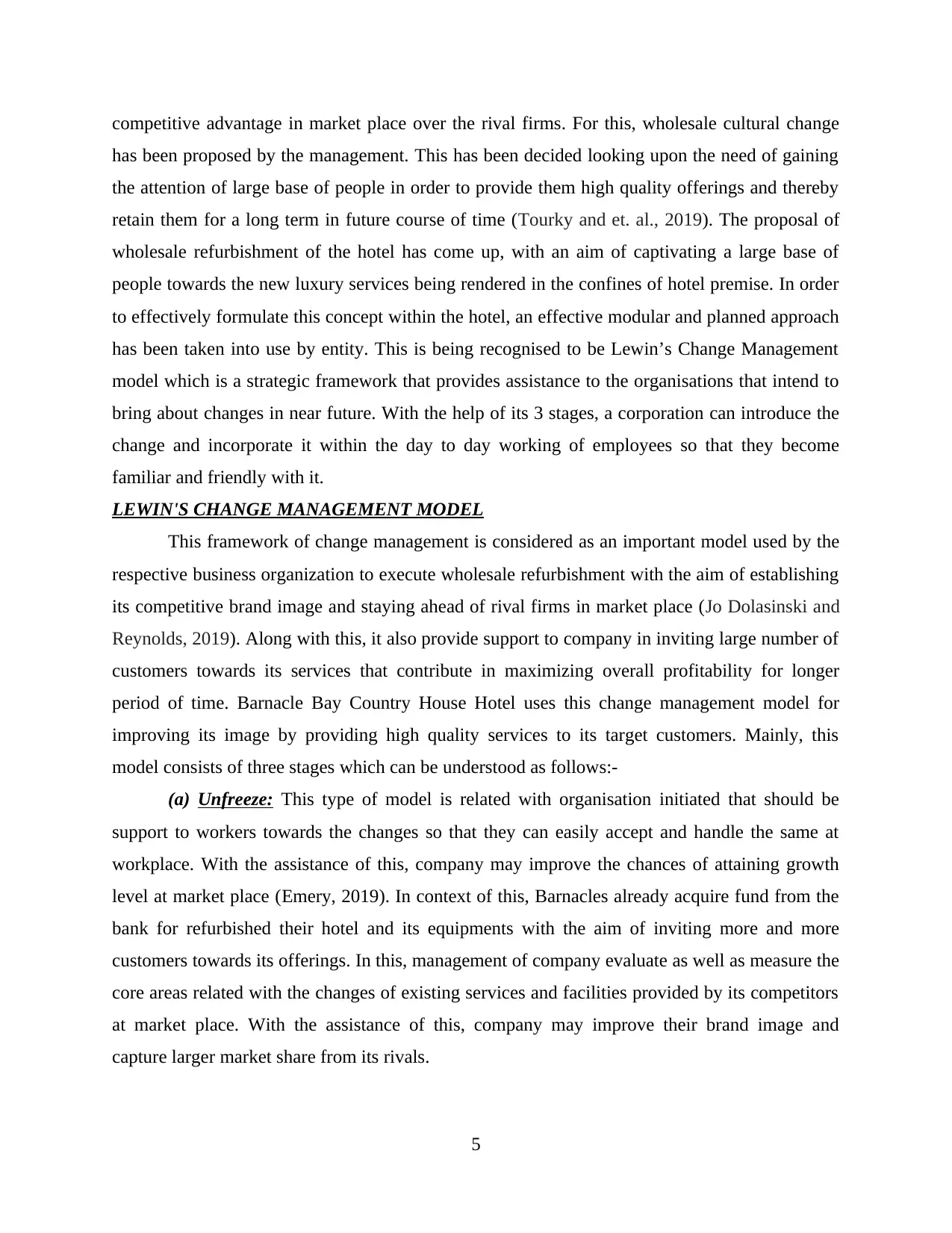
competitive advantage in market place over the rival firms. For this, wholesale cultural change
has been proposed by the management. This has been decided looking upon the need of gaining
the attention of large base of people in order to provide them high quality offerings and thereby
retain them for a long term in future course of time (Tourky and et. al., 2019). The proposal of
wholesale refurbishment of the hotel has come up, with an aim of captivating a large base of
people towards the new luxury services being rendered in the confines of hotel premise. In order
to effectively formulate this concept within the hotel, an effective modular and planned approach
has been taken into use by entity. This is being recognised to be Lewin’s Change Management
model which is a strategic framework that provides assistance to the organisations that intend to
bring about changes in near future. With the help of its 3 stages, a corporation can introduce the
change and incorporate it within the day to day working of employees so that they become
familiar and friendly with it.
LEWIN'S CHANGE MANAGEMENT MODEL
This framework of change management is considered as an important model used by the
respective business organization to execute wholesale refurbishment with the aim of establishing
its competitive brand image and staying ahead of rival firms in market place (Jo Dolasinski and
Reynolds, 2019). Along with this, it also provide support to company in inviting large number of
customers towards its services that contribute in maximizing overall profitability for longer
period of time. Barnacle Bay Country House Hotel uses this change management model for
improving its image by providing high quality services to its target customers. Mainly, this
model consists of three stages which can be understood as follows:-
(a) Unfreeze: This type of model is related with organisation initiated that should be
support to workers towards the changes so that they can easily accept and handle the same at
workplace. With the assistance of this, company may improve the chances of attaining growth
level at market place (Emery, 2019). In context of this, Barnacles already acquire fund from the
bank for refurbished their hotel and its equipments with the aim of inviting more and more
customers towards its offerings. In this, management of company evaluate as well as measure the
core areas related with the changes of existing services and facilities provided by its competitors
at market place. With the assistance of this, company may improve their brand image and
capture larger market share from its rivals.
5
has been proposed by the management. This has been decided looking upon the need of gaining
the attention of large base of people in order to provide them high quality offerings and thereby
retain them for a long term in future course of time (Tourky and et. al., 2019). The proposal of
wholesale refurbishment of the hotel has come up, with an aim of captivating a large base of
people towards the new luxury services being rendered in the confines of hotel premise. In order
to effectively formulate this concept within the hotel, an effective modular and planned approach
has been taken into use by entity. This is being recognised to be Lewin’s Change Management
model which is a strategic framework that provides assistance to the organisations that intend to
bring about changes in near future. With the help of its 3 stages, a corporation can introduce the
change and incorporate it within the day to day working of employees so that they become
familiar and friendly with it.
LEWIN'S CHANGE MANAGEMENT MODEL
This framework of change management is considered as an important model used by the
respective business organization to execute wholesale refurbishment with the aim of establishing
its competitive brand image and staying ahead of rival firms in market place (Jo Dolasinski and
Reynolds, 2019). Along with this, it also provide support to company in inviting large number of
customers towards its services that contribute in maximizing overall profitability for longer
period of time. Barnacle Bay Country House Hotel uses this change management model for
improving its image by providing high quality services to its target customers. Mainly, this
model consists of three stages which can be understood as follows:-
(a) Unfreeze: This type of model is related with organisation initiated that should be
support to workers towards the changes so that they can easily accept and handle the same at
workplace. With the assistance of this, company may improve the chances of attaining growth
level at market place (Emery, 2019). In context of this, Barnacles already acquire fund from the
bank for refurbished their hotel and its equipments with the aim of inviting more and more
customers towards its offerings. In this, management of company evaluate as well as measure the
core areas related with the changes of existing services and facilities provided by its competitors
at market place. With the assistance of this, company may improve their brand image and
capture larger market share from its rivals.
5
Paraphrase This Document
Need a fresh take? Get an instant paraphrase of this document with our AI Paraphraser
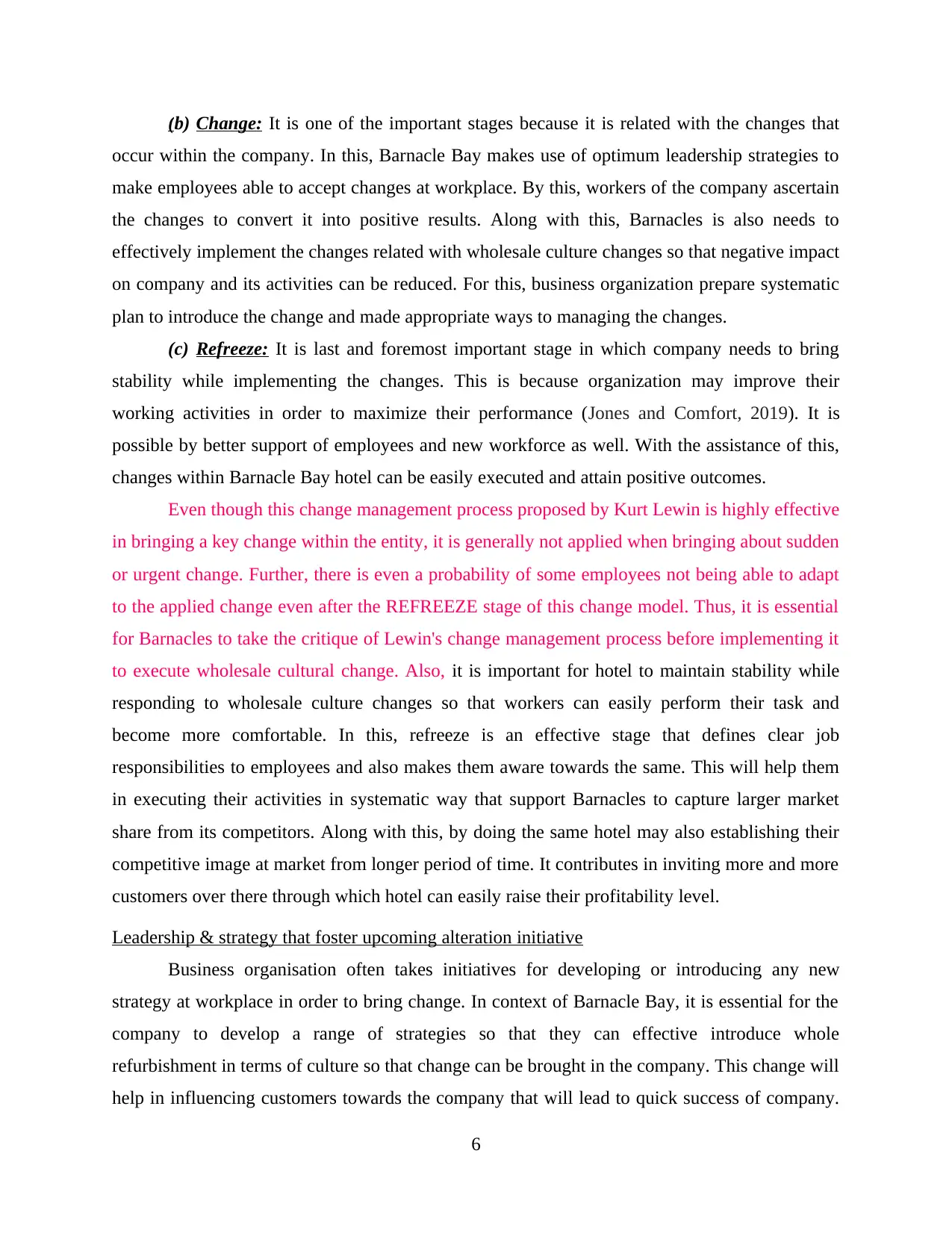
(b) Change: It is one of the important stages because it is related with the changes that
occur within the company. In this, Barnacle Bay makes use of optimum leadership strategies to
make employees able to accept changes at workplace. By this, workers of the company ascertain
the changes to convert it into positive results. Along with this, Barnacles is also needs to
effectively implement the changes related with wholesale culture changes so that negative impact
on company and its activities can be reduced. For this, business organization prepare systematic
plan to introduce the change and made appropriate ways to managing the changes.
(c) Refreeze: It is last and foremost important stage in which company needs to bring
stability while implementing the changes. This is because organization may improve their
working activities in order to maximize their performance (Jones and Comfort, 2019). It is
possible by better support of employees and new workforce as well. With the assistance of this,
changes within Barnacle Bay hotel can be easily executed and attain positive outcomes.
Even though this change management process proposed by Kurt Lewin is highly effective
in bringing a key change within the entity, it is generally not applied when bringing about sudden
or urgent change. Further, there is even a probability of some employees not being able to adapt
to the applied change even after the REFREEZE stage of this change model. Thus, it is essential
for Barnacles to take the critique of Lewin's change management process before implementing it
to execute wholesale cultural change. Also, it is important for hotel to maintain stability while
responding to wholesale culture changes so that workers can easily perform their task and
become more comfortable. In this, refreeze is an effective stage that defines clear job
responsibilities to employees and also makes them aware towards the same. This will help them
in executing their activities in systematic way that support Barnacles to capture larger market
share from its competitors. Along with this, by doing the same hotel may also establishing their
competitive image at market from longer period of time. It contributes in inviting more and more
customers over there through which hotel can easily raise their profitability level.
Leadership & strategy that foster upcoming alteration initiative
Business organisation often takes initiatives for developing or introducing any new
strategy at workplace in order to bring change. In context of Barnacle Bay, it is essential for the
company to develop a range of strategies so that they can effective introduce whole
refurbishment in terms of culture so that change can be brought in the company. This change will
help in influencing customers towards the company that will lead to quick success of company.
6
occur within the company. In this, Barnacle Bay makes use of optimum leadership strategies to
make employees able to accept changes at workplace. By this, workers of the company ascertain
the changes to convert it into positive results. Along with this, Barnacles is also needs to
effectively implement the changes related with wholesale culture changes so that negative impact
on company and its activities can be reduced. For this, business organization prepare systematic
plan to introduce the change and made appropriate ways to managing the changes.
(c) Refreeze: It is last and foremost important stage in which company needs to bring
stability while implementing the changes. This is because organization may improve their
working activities in order to maximize their performance (Jones and Comfort, 2019). It is
possible by better support of employees and new workforce as well. With the assistance of this,
changes within Barnacle Bay hotel can be easily executed and attain positive outcomes.
Even though this change management process proposed by Kurt Lewin is highly effective
in bringing a key change within the entity, it is generally not applied when bringing about sudden
or urgent change. Further, there is even a probability of some employees not being able to adapt
to the applied change even after the REFREEZE stage of this change model. Thus, it is essential
for Barnacles to take the critique of Lewin's change management process before implementing it
to execute wholesale cultural change. Also, it is important for hotel to maintain stability while
responding to wholesale culture changes so that workers can easily perform their task and
become more comfortable. In this, refreeze is an effective stage that defines clear job
responsibilities to employees and also makes them aware towards the same. This will help them
in executing their activities in systematic way that support Barnacles to capture larger market
share from its competitors. Along with this, by doing the same hotel may also establishing their
competitive image at market from longer period of time. It contributes in inviting more and more
customers over there through which hotel can easily raise their profitability level.
Leadership & strategy that foster upcoming alteration initiative
Business organisation often takes initiatives for developing or introducing any new
strategy at workplace in order to bring change. In context of Barnacle Bay, it is essential for the
company to develop a range of strategies so that they can effective introduce whole
refurbishment in terms of culture so that change can be brought in the company. This change will
help in influencing customers towards the company that will lead to quick success of company.
6
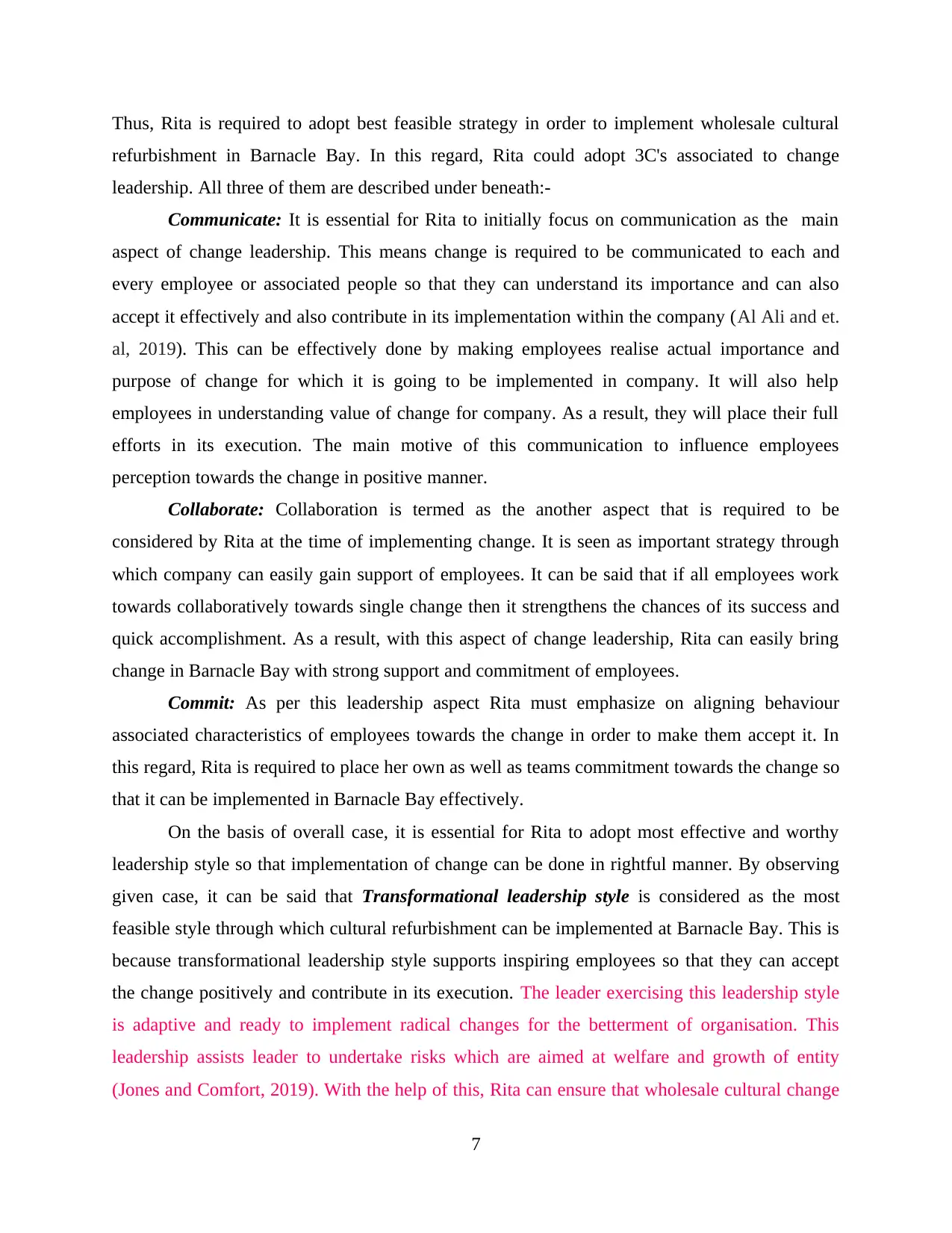
Thus, Rita is required to adopt best feasible strategy in order to implement wholesale cultural
refurbishment in Barnacle Bay. In this regard, Rita could adopt 3C's associated to change
leadership. All three of them are described under beneath:-
Communicate: It is essential for Rita to initially focus on communication as the main
aspect of change leadership. This means change is required to be communicated to each and
every employee or associated people so that they can understand its importance and can also
accept it effectively and also contribute in its implementation within the company (Al Ali and et.
al, 2019). This can be effectively done by making employees realise actual importance and
purpose of change for which it is going to be implemented in company. It will also help
employees in understanding value of change for company. As a result, they will place their full
efforts in its execution. The main motive of this communication to influence employees
perception towards the change in positive manner.
Collaborate: Collaboration is termed as the another aspect that is required to be
considered by Rita at the time of implementing change. It is seen as important strategy through
which company can easily gain support of employees. It can be said that if all employees work
towards collaboratively towards single change then it strengthens the chances of its success and
quick accomplishment. As a result, with this aspect of change leadership, Rita can easily bring
change in Barnacle Bay with strong support and commitment of employees.
Commit: As per this leadership aspect Rita must emphasize on aligning behaviour
associated characteristics of employees towards the change in order to make them accept it. In
this regard, Rita is required to place her own as well as teams commitment towards the change so
that it can be implemented in Barnacle Bay effectively.
On the basis of overall case, it is essential for Rita to adopt most effective and worthy
leadership style so that implementation of change can be done in rightful manner. By observing
given case, it can be said that Transformational leadership style is considered as the most
feasible style through which cultural refurbishment can be implemented at Barnacle Bay. This is
because transformational leadership style supports inspiring employees so that they can accept
the change positively and contribute in its execution. The leader exercising this leadership style
is adaptive and ready to implement radical changes for the betterment of organisation. This
leadership assists leader to undertake risks which are aimed at welfare and growth of entity
(Jones and Comfort, 2019). With the help of this, Rita can ensure that wholesale cultural change
7
refurbishment in Barnacle Bay. In this regard, Rita could adopt 3C's associated to change
leadership. All three of them are described under beneath:-
Communicate: It is essential for Rita to initially focus on communication as the main
aspect of change leadership. This means change is required to be communicated to each and
every employee or associated people so that they can understand its importance and can also
accept it effectively and also contribute in its implementation within the company (Al Ali and et.
al, 2019). This can be effectively done by making employees realise actual importance and
purpose of change for which it is going to be implemented in company. It will also help
employees in understanding value of change for company. As a result, they will place their full
efforts in its execution. The main motive of this communication to influence employees
perception towards the change in positive manner.
Collaborate: Collaboration is termed as the another aspect that is required to be
considered by Rita at the time of implementing change. It is seen as important strategy through
which company can easily gain support of employees. It can be said that if all employees work
towards collaboratively towards single change then it strengthens the chances of its success and
quick accomplishment. As a result, with this aspect of change leadership, Rita can easily bring
change in Barnacle Bay with strong support and commitment of employees.
Commit: As per this leadership aspect Rita must emphasize on aligning behaviour
associated characteristics of employees towards the change in order to make them accept it. In
this regard, Rita is required to place her own as well as teams commitment towards the change so
that it can be implemented in Barnacle Bay effectively.
On the basis of overall case, it is essential for Rita to adopt most effective and worthy
leadership style so that implementation of change can be done in rightful manner. By observing
given case, it can be said that Transformational leadership style is considered as the most
feasible style through which cultural refurbishment can be implemented at Barnacle Bay. This is
because transformational leadership style supports inspiring employees so that they can accept
the change positively and contribute in its execution. The leader exercising this leadership style
is adaptive and ready to implement radical changes for the betterment of organisation. This
leadership assists leader to undertake risks which are aimed at welfare and growth of entity
(Jones and Comfort, 2019). With the help of this, Rita can ensure that wholesale cultural change
7
⊘ This is a preview!⊘
Do you want full access?
Subscribe today to unlock all pages.

Trusted by 1+ million students worldwide
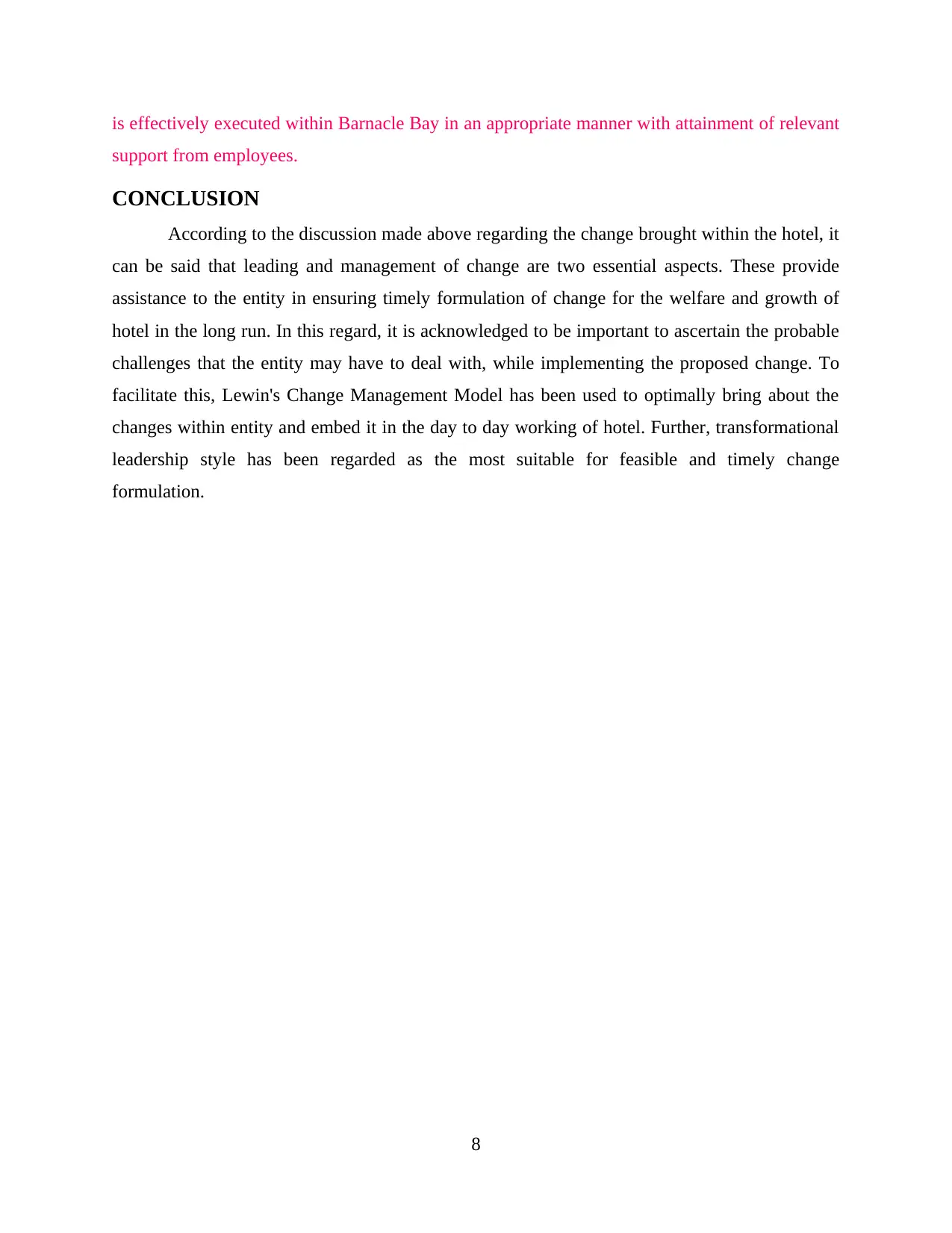
is effectively executed within Barnacle Bay in an appropriate manner with attainment of relevant
support from employees.
CONCLUSION
According to the discussion made above regarding the change brought within the hotel, it
can be said that leading and management of change are two essential aspects. These provide
assistance to the entity in ensuring timely formulation of change for the welfare and growth of
hotel in the long run. In this regard, it is acknowledged to be important to ascertain the probable
challenges that the entity may have to deal with, while implementing the proposed change. To
facilitate this, Lewin's Change Management Model has been used to optimally bring about the
changes within entity and embed it in the day to day working of hotel. Further, transformational
leadership style has been regarded as the most suitable for feasible and timely change
formulation.
8
support from employees.
CONCLUSION
According to the discussion made above regarding the change brought within the hotel, it
can be said that leading and management of change are two essential aspects. These provide
assistance to the entity in ensuring timely formulation of change for the welfare and growth of
hotel in the long run. In this regard, it is acknowledged to be important to ascertain the probable
challenges that the entity may have to deal with, while implementing the proposed change. To
facilitate this, Lewin's Change Management Model has been used to optimally bring about the
changes within entity and embed it in the day to day working of hotel. Further, transformational
leadership style has been regarded as the most suitable for feasible and timely change
formulation.
8
Paraphrase This Document
Need a fresh take? Get an instant paraphrase of this document with our AI Paraphraser
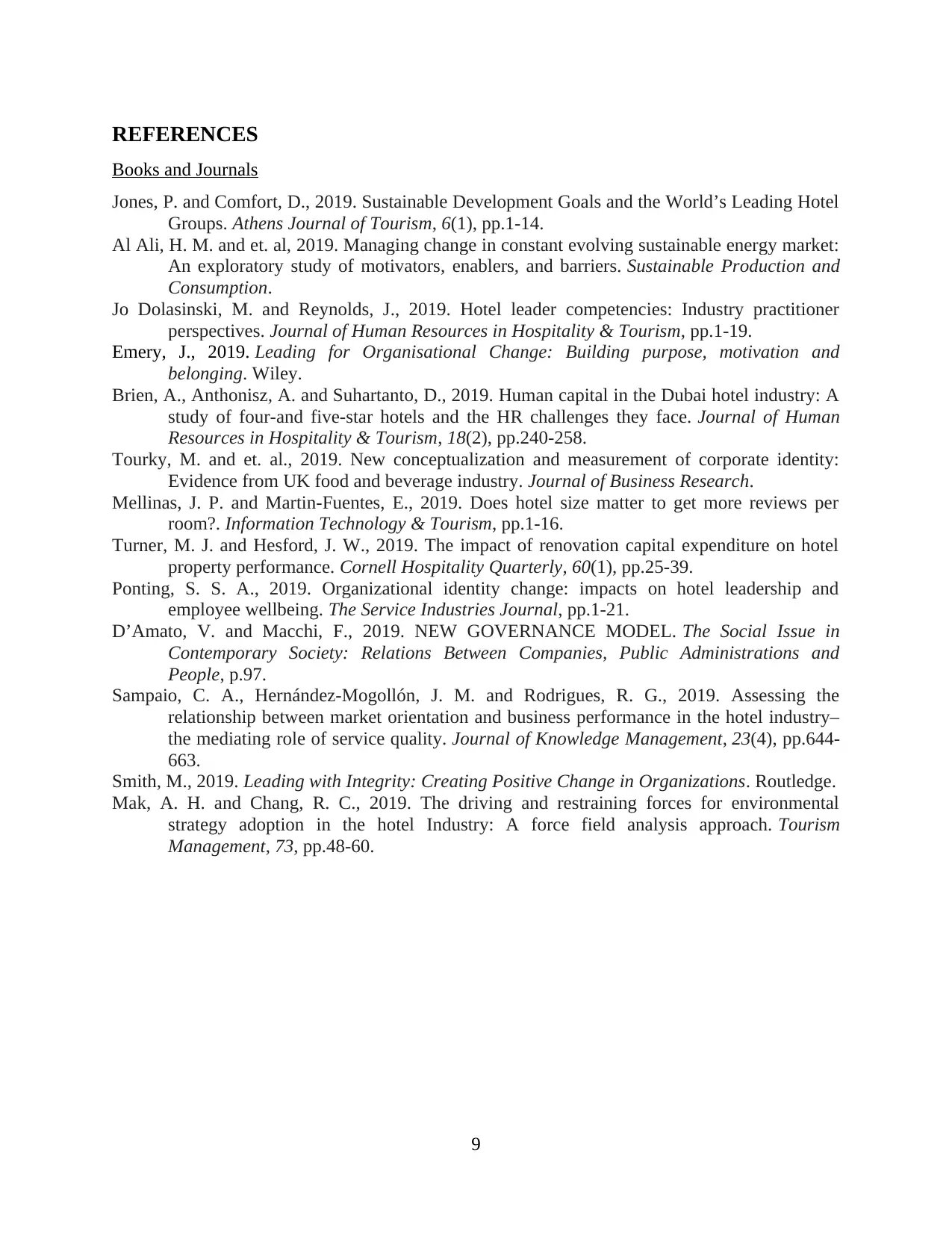
REFERENCES
Books and Journals
Jones, P. and Comfort, D., 2019. Sustainable Development Goals and the World’s Leading Hotel
Groups. Athens Journal of Tourism, 6(1), pp.1-14.
Al Ali, H. M. and et. al, 2019. Managing change in constant evolving sustainable energy market:
An exploratory study of motivators, enablers, and barriers. Sustainable Production and
Consumption.
Jo Dolasinski, M. and Reynolds, J., 2019. Hotel leader competencies: Industry practitioner
perspectives. Journal of Human Resources in Hospitality & Tourism, pp.1-19.
Emery, J., 2019. Leading for Organisational Change: Building purpose, motivation and
belonging. Wiley.
Brien, A., Anthonisz, A. and Suhartanto, D., 2019. Human capital in the Dubai hotel industry: A
study of four-and five-star hotels and the HR challenges they face. Journal of Human
Resources in Hospitality & Tourism, 18(2), pp.240-258.
Tourky, M. and et. al., 2019. New conceptualization and measurement of corporate identity:
Evidence from UK food and beverage industry. Journal of Business Research.
Mellinas, J. P. and Martin-Fuentes, E., 2019. Does hotel size matter to get more reviews per
room?. Information Technology & Tourism, pp.1-16.
Turner, M. J. and Hesford, J. W., 2019. The impact of renovation capital expenditure on hotel
property performance. Cornell Hospitality Quarterly, 60(1), pp.25-39.
Ponting, S. S. A., 2019. Organizational identity change: impacts on hotel leadership and
employee wellbeing. The Service Industries Journal, pp.1-21.
D’Amato, V. and Macchi, F., 2019. NEW GOVERNANCE MODEL. The Social Issue in
Contemporary Society: Relations Between Companies, Public Administrations and
People, p.97.
Sampaio, C. A., Hernández-Mogollón, J. M. and Rodrigues, R. G., 2019. Assessing the
relationship between market orientation and business performance in the hotel industry–
the mediating role of service quality. Journal of Knowledge Management, 23(4), pp.644-
663.
Smith, M., 2019. Leading with Integrity: Creating Positive Change in Organizations. Routledge.
Mak, A. H. and Chang, R. C., 2019. The driving and restraining forces for environmental
strategy adoption in the hotel Industry: A force field analysis approach. Tourism
Management, 73, pp.48-60.
9
Books and Journals
Jones, P. and Comfort, D., 2019. Sustainable Development Goals and the World’s Leading Hotel
Groups. Athens Journal of Tourism, 6(1), pp.1-14.
Al Ali, H. M. and et. al, 2019. Managing change in constant evolving sustainable energy market:
An exploratory study of motivators, enablers, and barriers. Sustainable Production and
Consumption.
Jo Dolasinski, M. and Reynolds, J., 2019. Hotel leader competencies: Industry practitioner
perspectives. Journal of Human Resources in Hospitality & Tourism, pp.1-19.
Emery, J., 2019. Leading for Organisational Change: Building purpose, motivation and
belonging. Wiley.
Brien, A., Anthonisz, A. and Suhartanto, D., 2019. Human capital in the Dubai hotel industry: A
study of four-and five-star hotels and the HR challenges they face. Journal of Human
Resources in Hospitality & Tourism, 18(2), pp.240-258.
Tourky, M. and et. al., 2019. New conceptualization and measurement of corporate identity:
Evidence from UK food and beverage industry. Journal of Business Research.
Mellinas, J. P. and Martin-Fuentes, E., 2019. Does hotel size matter to get more reviews per
room?. Information Technology & Tourism, pp.1-16.
Turner, M. J. and Hesford, J. W., 2019. The impact of renovation capital expenditure on hotel
property performance. Cornell Hospitality Quarterly, 60(1), pp.25-39.
Ponting, S. S. A., 2019. Organizational identity change: impacts on hotel leadership and
employee wellbeing. The Service Industries Journal, pp.1-21.
D’Amato, V. and Macchi, F., 2019. NEW GOVERNANCE MODEL. The Social Issue in
Contemporary Society: Relations Between Companies, Public Administrations and
People, p.97.
Sampaio, C. A., Hernández-Mogollón, J. M. and Rodrigues, R. G., 2019. Assessing the
relationship between market orientation and business performance in the hotel industry–
the mediating role of service quality. Journal of Knowledge Management, 23(4), pp.644-
663.
Smith, M., 2019. Leading with Integrity: Creating Positive Change in Organizations. Routledge.
Mak, A. H. and Chang, R. C., 2019. The driving and restraining forces for environmental
strategy adoption in the hotel Industry: A force field analysis approach. Tourism
Management, 73, pp.48-60.
9
1 out of 11
Related Documents
Your All-in-One AI-Powered Toolkit for Academic Success.
+13062052269
info@desklib.com
Available 24*7 on WhatsApp / Email
![[object Object]](/_next/static/media/star-bottom.7253800d.svg)
Unlock your academic potential
Copyright © 2020–2025 A2Z Services. All Rights Reserved. Developed and managed by ZUCOL.





